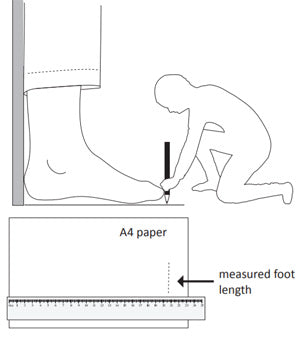Recommended Sizing for some kybun Footwear with "Slim Fit" Soles
kybun advises their customers to measure their foot length first and use their chart to look up which size to get, rather than just going by your usual size. That's because many of their models come in an extra wide (4E) width and so can accommodate virtually any foot if selected primarily on the basis of length, whereas a lot of footwear we are accustomed to only comes in a medium width, so we get used to having to buy them a little longer than we need.
The method kybun recommends is thus to:
1) Measure your foot from the back of the heel bone to the very tip of the longest toe (on the largest foot, if there is a difference) ...by placing two sheets of paper (or some other flat material you can draw a line on) at least as big as your feet on the floor right in front of a door or a wall, oriented so you can stand on them; taking your shoes off, and/or putting on socks of the same thickness you'd normally wear with this style of footwear; standing upright on top of each sheet, placing your full weight on both feet, with the backs of your feet flush with the door/wall; having someone else draw a line (because the feet can shorten when we bend over) along the front of the longest toe (which is usually, but not always the big toe) of each foot; and then you just measure the length from those lines to the bottom of the sheets with a ruler or tape measure. 2) Then look up the largest foot's length in the table they provide, and find the recommended U.S. or European size on the adjacent columns.
2) Then look up the largest foot's length in the table they provide, and find the recommended U.S. or European size on the adjacent columns.
However, that advice is better suited to the wider 'Comfort' sole, rather than the 'Slim Fit' sole, particularly if the uppers on the slimfoot models are not especially wide, either. For these, the standard kybun table is likely still fine for narrow feet, but for wider feet, some retailers advise that you should probably go either a half or a full size higher than that, depending on which part of your foot is widest.
These next two tables present those amended recommendations, first for Women's shoes, and then for Men's. Their central column for entirely narrow feet is the same result for that foot length as on kybun's regular tables (which have been consolidated on our Recommended Sizing for the kybun Footwear with Wide Soles page), but then they diverge from that in the final two columns if you have a wider mid- or fore-foot.
The upshot for this is simply that if you have fairly wide feet, you should probably just purchase the U.S. or European size you normally wear, even if the standard kybun table would suggest a different size for your actual length.
Recommended Size Equivalents, for Women's kybun shoes with a "Slimfit" Sole
| Length of Bare Foot | Suggested U.S. Size for Your Foot Width | |||
| MM | Inches | Narrow Foot | Wide Midfoot | Wide Forefoot |
| 215 | 8 7/16 | 5 | 5.5 | 6 |
| 220 | 8 11/16 | 5.5 | 6 | 6.5 |
| 225 | 8 7/8 | 6 | 6.5 | 7 |
| 230 | 9 1/16 | 6.5 | 7 | 7.5 |
| 235 | 9 1/4 | 7 | 7.5 | 8 |
| 240 | 9 7/16 | 7.5 | 8 | 8.5 |
| 245 | 9 5/8 | 8 | 8.5 | 9 |
| 250 | 9 13/16 | 8.5 | 9 | 9.5 |
| 255 | 10 1/16 | 9 | 9.5 | 10 |
| 260 | 10 1/4 | 9.5 | 10 | 10.5 |
| 265 | 10 7/16 | 10 | 10.5 | 11 |
| 270 | 10 5/8 | 10.5 | 11 | 11.5 |
| 275 | 10 13/16 | 11 | 11.5 | 12 |
| 280 | 11 | 11.5 | 12 | 12.5 |
Recommended Size Equivalents, for Men's kybun shoes with a "Slimfit" Sole
| Length of Bare Foot | Suggested U.S. Size for Your Foot Width | |||
| MM | Inches | Narrow Foot | Wide Midfoot | Wide Forefoot |
| 250 | 9 13/16 | 6.5 | 7 | 7.5 |
| 255 | 10 1/16 | 7 | 7.5 | 8 |
| 260 | 10 1/4 | 7.5 | 8 | 8.5 |
| 265 | 10 7/16 | 8 | 8.5 | 9 |
| 270 | 10 5/8 | 8.5 | 9 | 9.5 |
| 275 | 10 13/16 | 9 | 9.5 | 10 |
| 280 | 11 | 9.5 | 10 | 10.5 |
| 285 | 11 1/4 | 10 | 10.5 | 11 |
| 290 | 11 7/16 | 10.5 | 11 | 11.5 |
| 295 | 11 5/8 | 11 | 11.5 | 12 |
| 300 | 11 13/16 | 11.5 | 12 | 12.5 |
| 305 | 12 | 12 | 12.5 | 13 |
| 310 | 12 3/16 | 12.5 | 13 | 13.5 |
| 315 | 12 3/8 | 13 | 13.5 | 14 |
| 320 | 12 5/8 | 13.5 | 14 | 14.5 |
| 325 | 12 13/16 | 14 | 14.5 | 15 |
